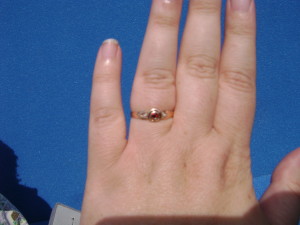A lot of times people ask about the engagement ring that is generally accepted as the one Laura received from Almanzo as pictured in the 1885 Montgomery Ward Catalog. It’s given a list price of $1.40, I decided to see just how much that was. Many people don’t understand or haven’t thought about how much the value of money changes over time. It’s a bit like trying to measure something using a measuring tape made of elastic that stretches or shrinks, so to get the best idea possible I consulted my favorite money calculator which gives a range of how you can interpret the changing purchasing power of money. I’ve included their answers for all the ways you calculate the value of money over time and then sum up down below. Basically the ways depend on comparing what that initial amount of money could have gotten you in the year you start, in this case 1884. Then you convert back to how much money it would take to get the same amount of the thing today. However, not all prices raise or fall the same and few products are exactly the same over time so you have to make allowances and you can come up with different answers. Also, there is a time lag do the time necessary to collect data and enter it into the system, so today we’ll be comparing the value of $1.40 between 1884 and 2011.
In 2011, the relative value of $1.40 from 1884 ranges from $30.90 to $1,790.00 depending on the system used.
A simple Purchasing Power Calculator would say the relative value is $33.10. This answer is obtained by multiplying $1.40 by the percentage increase in the CPI from 1884 to 2011. This is the most common measure and if you use a different online system to calculate the difference this is the system they most likely use although the numbers might not come out exactly the same due to weighting and rounding.
This may not be the best answer.
The best measure of the relative value over time depends on if you are interested in comparing the cost or value of a Commodity , Income or Wealth , or a Project . For more discussion on how to pick the best measure, read the essay “Explaining the Measures of Worth.”
If you want to compare the value of a $1.40 Commodity in 1884 there are three choices. In 2011 the relative:
- real price of that commodity is $33.10
- labor value of that commodity is $183.00(using the unskilled wage) or $324.00(using production worker compensation)
- income value of that commodity is $321.00
If you want to compare the value of a $1.40 Income or Wealth , in 1884 there are three choices. In 2011 the relative:
- historic standard of living value of that income or wealth is $33.10
- economic status value of that income or wealth is $321.00
- economic power value of that income or wealth is $1,790.00
If you want to compare the value of a $1.40 Project in 1884 there are four choices. In 2011 the relative:
- historic opportunity cost of that project is $30.90
- labor cost of that project is $183.00(using the unskilled wage) or
- $324.00(using production worker compensation)
- economy cost of that project is $1,790.00
So, using the most basic calculations, it’s as if the ring cost $33.10 and using the labor cost (which is the one Father Wilder uses to explain the value of 50 cents to Almanzo when he asks for a lemonade) it would be closer to $183.00, so maybe it wasn’t that bad a ring after all.
For more on the ring, check out Jonni Craven’s quest for the ring and the replica (out of much nicer materials than the original one was) that’s available to purchase from the Laura Ingalls Wilder museum in Walnut Grove.
UPDATE: I realized I should have linked to the ring in the Walnut Grove Museum giftshop as well. Find it here. Then scroll down.
Sarah S. Uthoff blogs at TrundleBed Tales; look for her on Facebook, Twitter , YouTube, Blog Talk Radio, Google+, LinkedIn, and Academia.edu Laura Ingalls Wilder Legacy and Research Association, Acting President





Comments10
That money calculator is great! Thanks for the resource.
You’re very welcome. I find it very useful. 🙂
Where is the original engagement ring? One of the homesites? If so, which one?
There is a possibility it was buried with her, but her jewelry box was stolen during the period between when Laura died and when they had a caretaker in place. It’s really sad because I’m sure there wasn’t anything there of any value except because Laura owned it and when they stole it that provenance was lost.
That is so awful! Why do people DO things like that? The history & sentimentality that have been stolen along with it…!
It’s missing in action, I believe.
When you compare the $1.40 Almanzo paid for Laura’s ring to what he would pay for a horse, kinda makes you wonder…
Could the ring have been lost in the fire? (Presumably she wasn’t wearing it every day while doing hard housework — pearls especially don’t stand up to that.)
I am in the process of calculating EVERY reference to money in the little house series. Every time I read the books and come across a dollar amount, I have to stop and look up the inflation. The lists become VERY handy when re-reading.
Do you know where that ring can be found now?
Comments are closed.